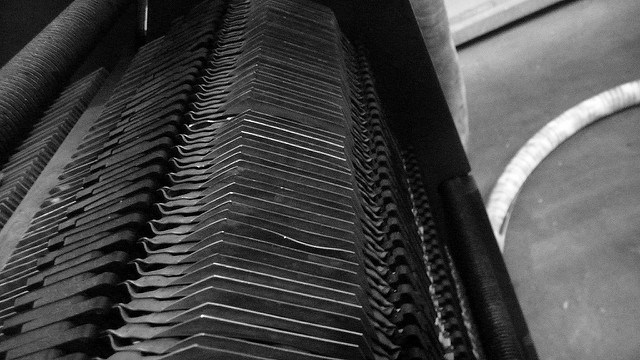
An overseas company manufactures brazed plate heat exchangers. This type of heat exchanger has a series of corrugated plates that are stacked onto each other. It is designed to create a turbulent flow for better heat transfer in a very compact size. The plates inside the heat exchanger are made of 321 stainless steel which is basically a 304 type of stainless steel but with a titanium stabilizer. This company would receive plain sheets of stainless steel material that were stacked on each other in a column. The dimensions of the plates were as follows: 305mm wide by 520mm long with a thickness of 0.5mm (12” Wide X 20.5” Long X 0.02” thick respectively). Each sheet weighed 635 grams (1.4 lbs.). They would set a stack of the stainless-steel sheets at the beginning of a press machine. The press machine would form the corrugated design into the face of the sheet. They were using a pick-and-place vacuum system to lift one sheet at a time to place inside the press. They started having problems with their process when occasionally two or three sheets would stick together. The underlying sheet could either fall onto the floor which would bend the sheet or be stacked inside the press which would cause an improper corrugation. Both issues were causing much scrap as well as downtime in their process .
They contacted EXAIR to find a way to improve the efficiency of their process. They wondered if static could be causing the “sticking” issues. Generally, static forces are really noticed with sheets made of plastic or non-conductive materials. The stronger the static force, the more issues with sticking and misalignment. EXAIR does offer Static Eliminators to remove static forces in applications just like this. But, with plain metal sheets, static is not a problem as the ions are able to balance themselves.
Typically, the main cause for metal sheets to “stick” together is surface tension. Liquid like water has a strong affinity to itself within the molecular structure, called cohesion, and to the surface that it lies on, called adhesion. The cohesion plus the adhesion to the metal surface can have a strong enough force to overcome the weight of the sheets. To break the surface tension, an additional force is required. An example of surface tension is with nylon tent material. The surface tension of water is strong enough to keep rain drops from penetrating the fabric. If you break the surface tension by touching the tent material, the surface will start to leak water. The same goes for the thin sheets of metal. We just need to break the surface tension to allow the sheets to separate.

I recommended two pieces of the model 1122, 2” Flat Super Air Nozzles. This nozzle gives a flat air pattern to force air between the sheets. Surface tension is based on force over length. Once the sheets start to separate, the contact length will decrease thus reducing the “sticking” force caused by surface tension. In this application, the amount of cohesion and adhesion forces caused by surface tension were unknown. Oil, water, and other liquids have different surface tensions which would require different amounts of blowing forces. To ensure the proper amount to separate the sheets, I recommended the shim set, model 1132SS.
The shims have different thicknesses that can be installed easily into the 2” Flat Super Air Nozzle to change the amount of blowing force. In conjunction with a regulator, this customer could “dial” in the proper amount of force required to counteract the surface tension from any type of liquid that may be on the surface of the sheets. I had them mount one nozzle at two different corners to help “peel” the sheets apart. The customer also tied in a solenoid valve into the compressed air system to cycle on the 2” Flat Super Air Nozzles only during the time when the vacuum system wanted to grab the top sheet. This reduced the amount of compressed air needed for their operation. After the installation, the procedure ran smoothly without downtime and scrap waste.
If your application is creating scrap and downtime caused by sheets sticking together, EXAIR has many types of products to help eliminate this. Whether the “stickiness” is caused from static or liquid adhesion, an Application Engineer can direct you to the best product to eliminate the “stickiness”. For the overseas company above, we were able to apply a sharp flat burst of air to overcome the surface tension between the sheets.
John Ball
International Application Engineer
Email: johnball@exair.com
Twitter: @EXAIR_jb
Heat Exchanger Plates by epicbeer. Creative Common by 2.0


